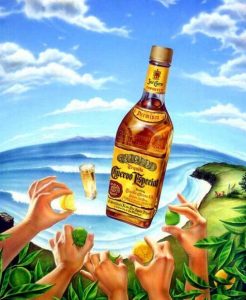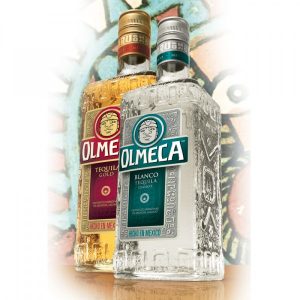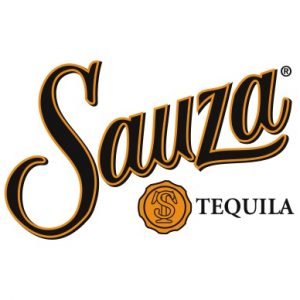Tequila
Spirit native of Mexico, obtained from the distillation of fermented juice of agave azul or agave Tequilana. The agave is a plant of the family Agavaceae with thorny leaves. By Mexican law the agave distillate can be defined Tequila only if produced from a particular type of agave, "agave azul" (Weber Agave Tequilana), grown in specific geographical areas: the federal state of Jalisco in Central-West Mexico. In the language of the local tribes Nahuatl the word Tequila means Volcano. The distillates obtained from the fermented juice of other species of agave are called Mezcal and are produced all over the Mexico. The Aztec legend tells that the god Quetzalcoatl, worried about the sadness that afflicted the men of the earth, made the goddess Mayahuel fall in love with him to lead her on earth, on the wings of the wind, in order to give men her extraordinary beauty. The grandmother of the goddess, enraged, directed to earth with an army of stars, to find her. The god Quetzalcoatl, to protect his beloved from the fury of her grandmother, picked her up and turned themselves into a tree, the branches of which were the body of his beloved. The grandmother of the Goddess, even more irritated by the attempted deception, ordered lightning and thunderbolts on the tree. The branches caught fire and burned. The god Quetzalcoatl, that came out from the trunk of the tree, picked up and bury the inert remains of the body of the goddess Mayahuel. From her limbs grew, as the fruit of not won love, the Agave plant, the plant of the gods, from heart of which the sacred water gutters that put an end to the sadness of men and women of the earth. The origins of Tequila and Mezcal go back to two thousand years ago. Around the first century AD, the locals discovered that the juice of the agave plant, when exposed to air, fermented in a milky mildly alcoholic beverage. The Aztecs called it "octyl poliqhui", a name that was later transformed by the Spanish in "pulque". As mentioned in the Aztec culture drinking "pulque" had a religious significance. It was consumed during public holidays when large containers full of pulque were arranged in squares. The ruling class, however, had the privilege of enjoying the drink throughout the year. It was even offered to prisoners of war to be purified before being sacrificed to the gods. The "conquistadores", that arrived in Mexico in the sixteenth century, initially did not like this drink of low alcohol content from about 3% by volume, with earthy and vegetable taste. They took with them, however, the stills and knowledge in the distillation. The first attempts to distill pulque were not exciting: the distillate had a sour and pungent taste; they had, then, the idea of cooking the agave pulp. The result was a sweeter juice which, when fermented, became known as Mezcal Wine. Once distilled was born the first Mezcal as we know it. The village of Tequila (named by the local Indians Ticuilas) produced Mezcal already at the seventeenth century. This spirit, made with the local agave azul, had a taste superior to others produced in the rest of Mexico and barrels of Mezcal wine of Tequila soon began to be marketed with the near Guadalajara and other cities even farther away. Gradually Mezcal produced in the future area of Jalisco came to be known as Tequila. The oldest distilleries in the town of Tequila date back to 1795, when the Spanish Crown granted a distiller license to Mr. Jose Cuervo. In 1805 was founded the distillery which became of the Sauza family. The distillation method for the Tequila and Mezcal is very similar. The agave reaches maturity after a time that varies between 8 and 10. Reached this it produces a flower stalk that, once started to grow, is cut by the farmer who directs back the growth in the central stem of the plant, causing swelling in the form of large bulb. When the bulge reaches the desired size, the plant is cut from the roots and spiny leaves are removed using a tool similar to a razor called the "coa". What remains it is the piña, which looks like a giant white and green pineapple weighing between 12 and 45 kg, full of sweet, juicy pulp. Arrived in the distillery Piñas are divided into four. As for Tequila, the starch content in the pulp is converted into sugars due to the heat of steam ovens or of large pressure cookers applied slowly. For what concerns Mezcal, the trasformation is obtained with underground ovens heated with charcoal, that gives the drink its characteristic smoky taste. After being cooked, they are crushed with a stone wheel, driven by a mule, to extract "the aguamiel", honey water. To obtain high-quality Tequila just agave juice mixed with a little water is fermented and distillated. When, besides water, are added sugars from various sources, such as cane, we will have a final product that will be defined as "mixto". The "mixto" produced and bottled in Mexico can contain up to 40% alcohol derived from other sugars, while those sent to foreign countries for bottling, especially in the United States, may have an agave content reduced by the foreign bottler to 51% . Mexican law establishes that Tequila 100% agave or aged Tequila has to be bottled in Mexico and that this feature should always be reported on the label of the bottle. If it is a "mixto", however, it is usually not mentioned on the label. The stills used for distillation are discontinuous and produce a clear distillate, containing a significant amount of spices, which can be distilled again in column pot stills to get a distillation cleaner and lighter. The color is generally enhanced by the addition of caramel, because the color from aging in the barrel is the exclusive prerogative of high quality brands. Some distillers add small amounts of natural flavorings such as prunes, coconut or Sherry, which, even if not significantly affect the taste of spirit, soften it changing the flavor profile. Tequila can be divided in four categories: Tequila Silver or Blanco, light in color, can be either 100% agave or mixto. It is not aged, just a slight aging in stainless steel containers for up to 60 days, it is indicated mainly for mixing; Tequila Gold, even this is not aged: is colored and flavored with caramel. Normally it is a mixto; Tequila Reposado, is aged in wooden casks or vats for a minimum period established by Mexican law, for two months. The best brands age from 3 to 9 months in wood casks. It can be either 100% agave or mixto and is the kind of best-selling Tequila in Mexico. Tequila Añejo is aged in wooden barrels (usually old barrels used for Bourbon) for a minimum of 12 months. The best Añejo are aged for 18 months to 3 years for mixto and even up to 4 years for 100% agave. Age Tequila for more than 4 years is a controversial matter. Many producers of Tequila are opposed because they believe that too much time in wood can cover the earthy and vegetal aromatic features of agave. The rules and regulations that govern the production and packaging of Tequila are not applied to Mezcal. Some distilleries are very primitive and very small. The most famous Mezcal is produced in the southern state of Oaxaca. Eight varieties of agave are allowed for the production of Mezcal, but the mainly used variety is agave "espadin" (Agave angustifolia Haw). In some bottles of Mezcal it is possible to find the "gusano", in English worm, which is actually the larva of one or two months that grows in the agave plant. It is said that the "gusano" serves as a checker of alcohol content: if the worm remains intact in the bottle it means that the percentage of alcohol in the distillate is high enough to preserve it in alcohol. At the same time, however, it has become a ritual for generations, to consume the "gusano". It should be emphasized that the best bottles of Mezcal has none and, indeed, begin to have a remarkable character and the quality level allows its to capture a small slice of the market. It is custom to drink the pure Tequila eating immediately before, a pinch of salt and, soon after, a slice of lemon. The most common cocktails is undoubtedly Margarita. There are many stories around the creation of a cocktail so popular: Daniel Negrete (1936), according to what says his son Salvador Negrete, opened a bar at the Garci Crispo hotel with his brother David, and the day before David's marriage Daniel presented the Margarita as a wedding gift for his sister-in-law, Margarita; The bartender Francisco “Pancho” Morales, July 4, 1942, in a bar named Tommy's Place in Juarez, Texas, improvised a cocktail to a customer because he did not remember the exact recipe of Magnolia, cocktail that she had requested. His creation had success; Carlos Danny Herrera, between 1947 and 1948, mixed white Tequila with lemon juice and Triple Sec for a showgirl who called herself Marjorie King. The actress was allergic to liquors, except Tequila, but she did not liked to drink it with salt and lemon. The cocktail that was presented was called Margarita.



